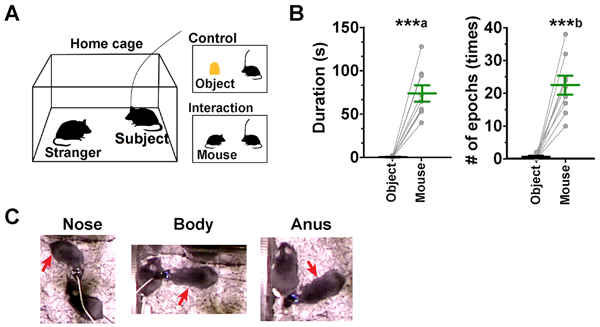A research team led by Professor TAKUMI Toru of Kobe University's Graduate School of Medicine (also a Senior Visiting Scientist at RIKEN Center for Biosystems Dynamics Research) have identified 'social cells' in the brain that are related to social behavior. The cells were identified via Ca imaging (*1) conducted using a microendoscope (*2). It is expected that further research will illuminate the neural network for decision-making in social behavior.
These research findings were published in the American scientific journal 'PLOS Biology' on September 21.
Main points
- Using a microendoscope, the research team discovered social cells in the cerebral insular cortex (*3) of mice that are related to social behavior.
- The insular cortex acts as an interface between social and emotional modules in the 'social decision-making network'.
- It is known that the insular cortex is altered in various neuropsychiatric disorders such as schizophrenia and autism. The results of this study provide insight into the social functions of the insular cortex at a cellular level
Research Background
Social distancing is one of the methods that is being endorsed to prevent widespread novel coronavirus infection. It has been said that a physical distance of 2 meters is necessary to prevent virus transmission. How are distances between people, socially distanced exchanges and societal interactions determined?
This kind of social behavior is a complex behavioral pattern consisting of 'sensory inputs', 'internal states' and 'decision making' that span the stages from 'sensory processing' to 'behavior modification'. The behavioral pattern sequence begins with individuals using multimodal (*4) sensory cues (such as sight, smell, hearing and touch) to process information about another individual. This information is then referenced against (social) internal states (such as motive, arousal, emotion, interoception and memory) and behavior is decided upon (for example, investigative, mating, aggressive, nurturing or dominating behaviors).
It is understood that regions of the brain such as the amygdala, pituitary, mesencephalon and the prefrontal cortex are involved in social behavior. However, the detailed neural networks of these regions are not yet well understood, particularly at a cellular level.
Methods to map neural activity across the entire brain have been developed. These include functional MRI and mapping the expression of immediate-early genes, such as c-fos. In addition, specific neural network regions in freely moving mice have been monitored by methods including fiber photometry and Ca imaging conducted using a miniaturized fluorescence microscope affixed to the rodent's head (as in this study), in addition to observations conducted with a two-photon microscope on mice with their heads fixed in place.
Research Methodology and Findings
A test mouse was placed in a 'home cage' and its behavior towards either a stranger mouse (that it had never come into contact with before) or a static object placed in the same cage was observed (Figure 1A). Both the duration and frequency of interactions between the test mouse and stranger mouse were significantly greater than the test mouse's interactions with the static object (Figure 1B). The test mouse demonstrated social behaviors, including contact with the nose, body and anus of the stranger mouse (Figure 1C).

Figure 1: A. Diagram showing experiment conditions. B. Contact duration and frequency of the test mouse's interactions with an object or a stranger mouse. C. Mouse-to-mouse contact behaviors.
The research team injected Ca indicator (GCaMP) (*5) into the insular cortex of mice using an adeno-associated virus vector. Next a GRIN lens (*6) was inserted into the agranular insular cortex (AI). This enabled the research team to use Ca imaging conducted via the miniaturized fluorescence microscope fixed to each mouse's head to record the neural activity of freely moving mice (Figure 2A).






